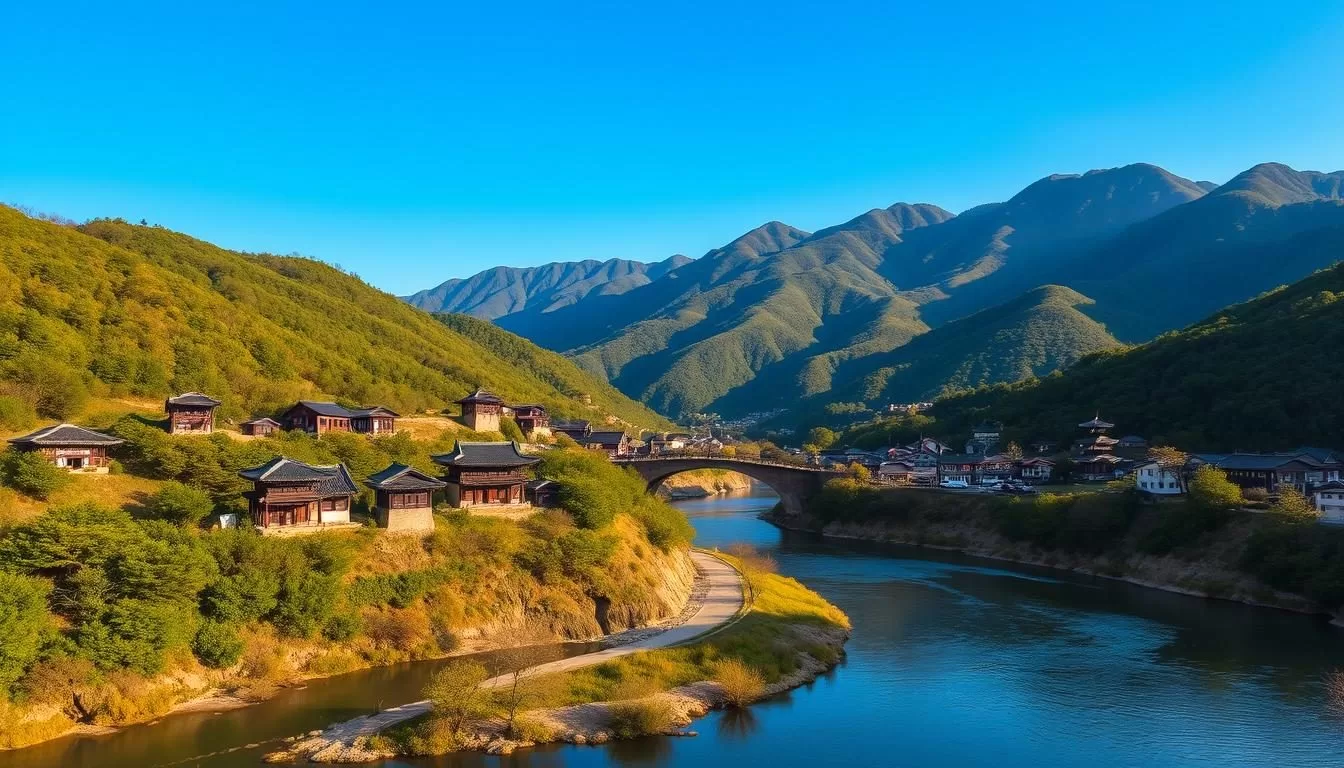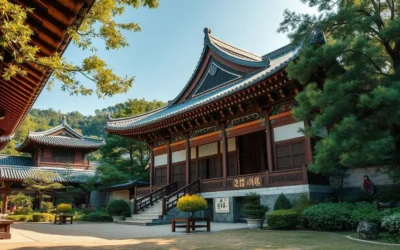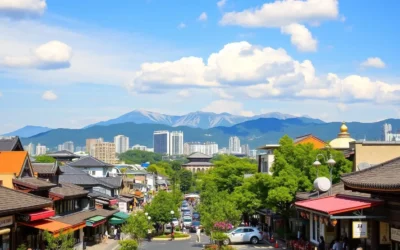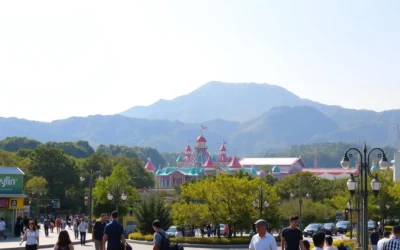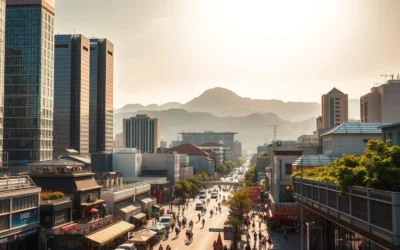✓ Accommodations✓ Flights✓ Rental Cars
Planning a trip to South Korea can be a thrilling experience, with North Gyeongsang Province offering a rich cultural heritage and diverse landscapes. The region’s distinct weather patterns throughout the year significantly impact your travel experience.
Understanding the best months to visit is crucial for a memorable journey. The spring and autumn months are particularly appealing, with mild temperatures and breathtaking scenery. By knowing what to expect from the weather during different months, you can make the most of your trip to this culturally rich region of South Korea.
This guide will help you navigate the region’s climate, ensuring a weather-savvy trip that aligns with your preferences and interests.
Understanding North Gyeongsang Province’s Climate
Understanding the climate of North Gyeongsang Province requires a look at its geography and seasonal patterns. North Gyeongsang Province, situated in the northeastern region of South Korea, has a climate that is significantly influenced by its geography.
Geographic Location and Weather Patterns
The province’s geography plays a crucial role in shaping its weather patterns. The mountainous terrain in parts of North Gyeongsang creates microclimates where temperatures and rainfall can differ from coastal areas within the same province.
For instance, areas like Pyeongchang, known for hosting the 2018 Winter Olympics, enjoy longer winters and shorter summers due to their high average elevation of 2,460 feet (750 meters). This variation in geography contributes to the diverse climate conditions across the province.
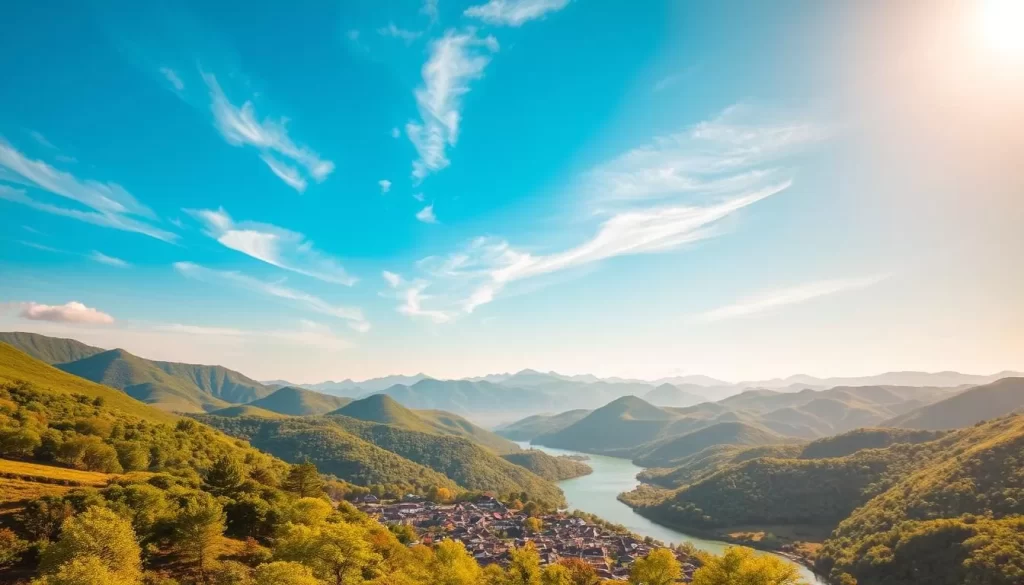
Four Distinct Seasons Overview
North Gyeongsang Province experiences four distinct seasons with significant temperature variations—from freezing winters to hot, humid summers. The weather considerations are crucial for travel planning due to these variations.
| Season | Temperature Range | Humidity/Rainfall |
|---|---|---|
| Winter | Freezing to below freezing | Low humidity, occasional snow |
| Summer | High 80s°F (around 30°C) | High humidity, significant rainfall during monsoon season |
| Spring/Autumn | Mild temperatures | Moderate conditions, less rainfall |
The province’s position makes it susceptible to seasonal weather phenomena, including “yellow dust” in spring and occasional typhoon effects in late summer. Understanding these conditions can help you plan your trip effectively.
Spring in North Gyeongsang: Cherry Blossoms and Mild Weather
The arrival of spring in North Gyeongsang Province marks a beautiful time to visit. As the weather warms up, the region transforms into a vibrant destination, attracting tourists from all over.
March to May Weather Conditions
Spring in North Gyeongsang Province, spanning from March to May, brings mild temperatures that gradually warm from around 50°F (10°C) in March to 70°F (21°C) by late May. This creates ideal conditions for outdoor activities and exploration. While the season is characterized by cool breezes and ample sunshine, it’s also a time when the “yellow dust” (hwang sa) phenomenon can occur, particularly in March and April.
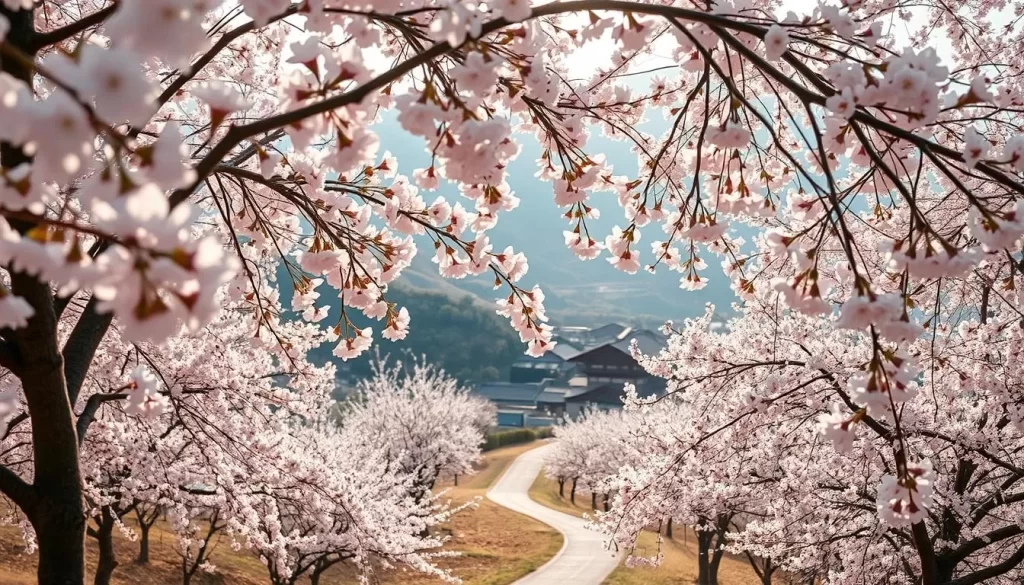
Cherry Blossom Season in Gyeongju
The cherry blossom season, typically peaking in early April, transforms Gyeongju into one of South Korea’s most photogenic destinations. Historic sites like Bulguksa Temple and Anapji Pond are framed by delicate pink blooms, making it a best time to visit for photography enthusiasts. The Bomun Lake area and Cheomseongdae Observatory are among the most spectacular spots to witness the cherry blossom trees in full bloom.
Spring Festivals and Cultural Events
Spring festivals in North Gyeongsang Province celebrate the season’s renewal. The Gyeongju Cherry Blossom Marathon in April and various temple festivals coinciding with Buddha’s Birthday celebrations in May are highlights. These events, along with the natural beauty of the season, make spring an ideal time to visit South Korea. Visitors can enjoy the comfortable temperatures and participate in cultural events that showcase the region’s heritage.
Summer Considerations: Heat, Humidity, and Monsoons
If you’re planning to visit North Gyeongsang Province in the summer, be prepared for the heat and humidity. Summer, which spans from June to August, is characterized by high temperatures and significant rainfall, making it a challenging time for outdoor activities.
June to August Temperature and Rainfall Patterns
During the summer months, temperatures in North Gyeongsang Province regularly exceed 85°F (29°C), with humidity levels often reaching 70-80%. The monsoon season, known as “jangma,” typically begins in late June and continues through July, bringing heavy rainfall that can disrupt travel plans. July is particularly wet, averaging 10-15 rainy days and significant precipitation.
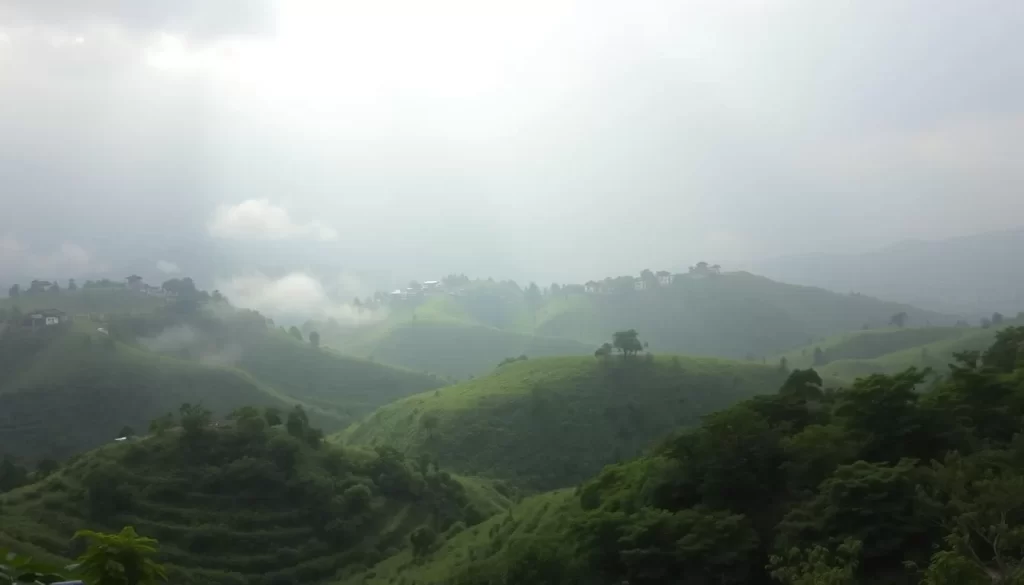
Summer Activities Despite the Heat
Despite the challenging weather conditions, summer offers unique opportunities to experience North Gyeongsang’s cultural festivals. You can enjoy the Andong International Mask Dance Festival if you’re traveling in late summer, as well as various local water festivals designed to help beat the heat. The mountainous areas, including Sobaeksan National Park, offer cooler temperatures and refreshing hiking opportunities, making them popular summer retreats.
Beating the Crowds During Peak Season
Summer is peak domestic tourism season in South Korea, with families traveling during school holidays. To make the most of your trip, plan outdoor activities for early morning or evening, seek air-conditioned cultural venues during the midday heat, and consider visiting lesser-known destinations within the province to avoid the largest crowds. By doing so, you can enjoy your time in North Gyeongsang Province even during the hot month of July and August.
Autumn’s Colorful Splendor: September to November
Autumn’s arrival in North Gyeongsang Province signals a spectacular display of fall foliage, attracting tourists from afar. The autumn season brings a welcome relief from the summer heat, with comfortable temperatures and vibrant colors transforming the landscape.
Fall Foliage Timeline and Best Viewing Spots
The fall foliage season typically begins in mid-October in the mountainous areas and peaks in late October to early November in lower elevations. Some of the prime foliage viewing locations include Sobaeksan National Park and Juwangsan National Park, as well as the historic areas around Andong and Gyeongju. These locations offer stunning backdrops for cultural heritage sites.
| Location | Peak Foliage Time |
|---|---|
| Sobaeksan National Park | Late October |
| Juwangsan National Park | Early November |
| Andong Historic Area | Late October |
| Gyeongju Historic Area | Early November |
Temperature and Precipitation Expectations
During the autumn season, from September to November, you can expect average daily temperatures to range from 66 to 70 degrees F (19 to 21 degrees C) initially, gradually dropping as the month progresses. Precipitation levels decrease significantly compared to summer, with October and November averaging just 5-7 rainy days per month.
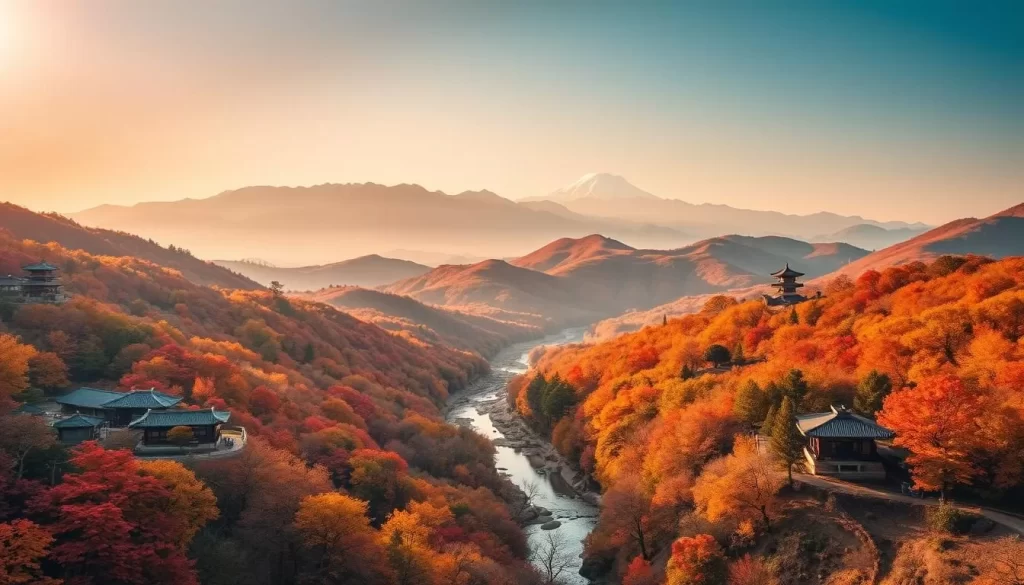
Chuseok and Autumn Festivals
Chuseok, or the Mid-Autumn Festival, is a significant cultural event that often falls in September or early October. It’s a time for family reunions and traditional foods. Beyond Chuseok, numerous cultural festivals take place, including the Andong Mask Dance Festival, showcasing traditional performances and crafts.
Visiting North Gyeongsang Province during the autumn season is ideal, with comfortable temperatures and fewer crowds compared to the peak summer months. If you’re planning to visit South Korea, this is a great time to visit the region’s national parks and experience the local culture.
Winter Escapes: Cold Weather Adventures
Winter in North Gyeongsang Province is a season of contrasts, with cold temperatures, occasional snowfall, and a plethora of activities to enjoy. You can experience the serene beauty of snow-covered landscapes, participate in traditional winter festivals, or simply enjoy the crisp, clear air.
December to February Weather Conditions
During the winter months, temperatures in North Gyeongsang Province range from 20°F (-6°C) to 40°F (4°C), with January being the coldest month. Mountain areas experience even lower temperatures, making them ideal for snow sports. You can expect varying snowfall throughout the province, with mountainous regions receiving significant accumulation.
Winter Activities and Snow Experiences
Despite the cold, winter is an excellent time to enjoy various activities in North Gyeongsang Province. You can hit the slopes at ski resorts like Yangsan Alpine Ski Resort, go winter hiking in national parks with proper equipment, or relax in traditional hot springs. The crisp air also makes it an ideal time for photography, capturing the historic sites and natural landscapes without the haze or crowds.
Lunar New Year Celebrations
The Lunar New Year, or Seollal, is a significant cultural event in South Korea, typically occurring in January or February. You can experience traditional temple rites, family feasts, and ancestor commemorations. While it’s a great opportunity for cultural insights, be aware that it may also mean business closures and increased domestic travel, requiring advance planning for your trip.
North Gyeongsang Province, South Korea: Best Months for a Weather-Savvy Trip
North Gyeongsang Province, with its rich history and natural beauty, is a destination that benefits from careful timing. The province offers a diverse range of experiences throughout the year, from the vibrant cherry blossoms of spring to the colorful foliage of autumn.
Optimal Months for Different Travel Interests
For most travelers, the optimal months to visit North Gyeongsang Province are mid-April to early June and mid-September to early November, when temperatures are moderate and precipitation is relatively low. If you’re a photography enthusiast, you should target early April for cherry blossoms or late October for fall foliage, as these are considered the one best times to visit South Korea.
Cultural explorers may want to time their visit to coincide with specific festivals. Meanwhile, budget-conscious travelers will find better accommodation rates and fewer crowds during the shoulder seasons of late May to early June and late September to early October.
Avoiding Local Holiday Crowds and Price Surges
It’s essential to take local holidays into account when planning your trip to North Gyeongsang Province. The Korean New Year (Seollal) and Chuseok (Korean Thanksgiving) are times when many residents travel to their hometowns, and many businesses are closed. If you’re planning a multi-region trip, note that optimal weather windows may differ; for example, Jeju Island has milder winters but can be affected by different typhoon patterns.
For those sensitive to air quality, late autumn typically offers the clearest conditions, while spring travelers should monitor yellow dust forecasts. Winter sports enthusiasts have a narrower optimal window from late December through February when ski resorts maintain reliable snow conditions.
By choosing the right time to visit, you can enjoy a more relaxed and fulfilling experience in North Gyeongsang Province, avoiding the crowds and making the most of your trip.
Conclusion: Planning Your Perfect Weather-Timed Visit
As you plan your trip to North Gyeongsang Province, timing is everything to ensure a memorable experience. The province offers a rich tapestry of cultural and natural attractions, with the best times to visit being during the spring (April-May) and autumn (September-October). These periods offer not only comfortable weather but also spectacular natural scenery, with cherry blossoms blooming in early April and fall foliage peaking in late October.
To make the most of your visit to South Korea, consider your specific interests and the activities you wish to enjoy. Whether you’re interested in cultural festivals, outdoor activities, or simply exploring historical sites, timing your trip according to the local climate and event calendars can significantly enhance your experience. If you’re planning to visit other destinations like Jeju Island, be sure to research their specific weather patterns as well.
By balancing your preferences with the seasonal characteristics of North Gyeongsang Province, you can create a perfectly timed visit that showcases the best of what this fascinating region has to offer throughout the year.
The above is subject to change.
Check back often to TRAVEL.COM for the latest travel tips and deals.
